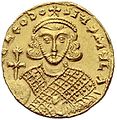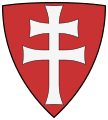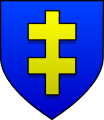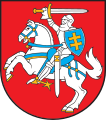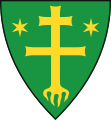
The Cross of Lorraine, known as the Cross of Anjou in the 16th century, is a heraldic two-barred cross, consisting of a vertical line crossed by two shorter horizontal bars. In most renditions, the horizontal bars are "graded" with the upper bar being the shorter, though variations with the bars of equal length are also seen. The Lorraine name has come to signify several cross variations, including the patriarchal cross with its bars near the top. The Cross of Lorraine came to the Duchy of Lorraine via the Kingdom of Hungary in the 15th century. Similar two-barred cross symbols prominently feature in heraldry from Poland, Lithuania and Belarus. Its ultimate origins are theorised to be Byzantine. The Cross of Lorraine was used as a symbol of Free France during World War II and was earlier used by French patriots to signify desire to reclaim provinces lost to Germany in the Franco-Prussian war.

Béla III was King of Hungary and Croatia between 1172 and 1196. He was the second son of King Géza II and Géza's wife, Euphrosyne of Kiev. Around 1161, Géza granted Béla a duchy, which included Croatia, central Dalmatia and possibly Sirmium. In accordance with a peace treaty between his elder brother, Stephen III, who succeeded their father in 1162, and the Byzantine Emperor Manuel I Komnenos, Béla moved to Constantinople in 1163. He was renamed to Alexios, and the emperor granted him the newly created senior court title of despotes. He was betrothed to the Emperor's daughter, Maria. Béla's patrimony caused armed conflicts between the Byzantine Empire and the Kingdom of Hungary between 1164 and 1167, because Stephen III attempted to hinder the Byzantines from taking control of Croatia, Dalmatia and Sirmium. Béla-Alexios, who was designated as Emperor Manuel's heir in 1165, took part in three Byzantine campaigns against Hungary. His betrothal to the emperor's daughter was dissolved after her brother, Alexios, was born in 1169. The emperor deprived Béla of his high title, granting him the inferior rank of kaisar.

The coat of arms of Lithuania is a mounted armoured knight holding a sword and shield, known as Vytis. Since the early 15th century, it has been Lithuania's official coat of arms and is one of the oldest European coats of arms. It is also known by other names in various languages, such as Waykimas, Pagaunė in the Lithuanian language or as Pogonia, Pogoń, Пагоня in the Polish, and Belarusian languages. Vytis is translatable as Chase, Pursuer, Knight or Horseman, similar to the Slavic vityaz. Historically – raitas senovės karžygys or in heraldry – raitas valdovas.

The Holy Crown of Hungary, also known as the Crown of Saint Stephen, named in honour of Saint Stephen I of Hungary, was the coronation crown used by the Kingdom of Hungary for most of its existence; kings have been crowned with it since the twelfth century. The Crown symbolized the King's authority over the Lands of the Hungarian Crown, and it was a key mark of legitimacy. Through the history of Hungary, more than fifty kings were crowned with it, until 1916 and the last king Charles IV. The only kings not so crowned were Wladyslaw I, John Sigismund Zápolya, and Joseph II.

The coat of arms of Ukraine is a blue shield with a gold trident. Officially referred to as the Emblem of the Royal State of Volodymyr the Great, or, colloquially, the tryzub, the insignia derives from the seal-trident of Volodymyr the Great, the first Grand Prince of Kyiv.

The coat of arms of Russia derives from the earlier coat of arms of the Russian Empire. Though modified more than once since the reign of Ivan III (1462–1505), the current coat of arms is directly derived from its medieval original, with the double-headed eagle having Byzantine and earlier antecedents. The general tincture corresponds to the fifteenth-century standard.

The Columns of Gediminas or Pillars of Gediminas are one of the earliest symbols of Lithuania and its historical coats of arms. They were used in the Grand Duchy of Lithuania, initially as a rulers' personal insignia, a state symbol, and later as a part of heraldic signs of leading aristocracy.

The globus cruciger, also known as "the orb and cross", is an orb surmounted by a cross. It has been a Christian symbol of authority since the Middle Ages, used on coins, in iconography, and with a sceptre as royal regalia.

The coat of arms of the Slovak Republic consists of a red (gules) shield, in early Gothic style, charged with a silver (argent) double cross standing on the middle peak of a dark blue mountain consisting of three peaks. Extremities of the cross are amplified, and its ends are concaved. The double cross is a symbol of its Christian faith and the hills represent three symbolic mountain ranges: Tatra, Fatra, and Matra.

The coat of arms of Montenegro was officially adopted by the law passed in the Parliament on 12 July 2004. It is now the central motif of the flag of Montenegro, as well as the coat of arms of the Armed Forces of Montenegro. It was constitutionally sanctioned by the Constitution proclaimed on 2 October 2007.

The coat of arms of the Bagrationi dynasty has been used by the former royal family of Georgia and its descendants. It is a symbol of the Bagrationi dynasty, which claims the erstwhile Georgian crown.
The national symbols of Lithuania are used in Lithuania and abroad to represent the country and its people, history, culture, and nature. These symbols are seen in official capacities, such as flags, coats of arms, postage stamps, and currency, and in URLs. They appear less formally as recurring themes in literature, art and folk art, heraldry, monuments, clothing, personal decoration, and as the names of parks, bridges, streets, and clubs. The less formal manifestations may be classified as national emblems.

Hungarian heraldry generally follows German heraldry in its artistic forms, but has its own distinctive character. It is classified to Central and Eastern European heraldry.

The Reichsadler is the heraldic eagle, derived from the Roman eagle standard, used by the Holy Roman Emperors and in modern coats of arms of Germany, including those of the Second German Empire (1871–1918), the Weimar Republic (1919–1933) and Nazi Germany (1933–1945).
Double Cross, Double Crossed, or their variants may refer to:
The Russian Orthodox Cross is a variation of the Christian cross since the 16th century in Russia, although it bears some similarity to a cross with a bottom crossbeam slanted the other way (upwards) found since the 6th century in the Byzantine Empire. The Russian Orthodox cross has three horizontal crossbeams, with the lowest one slanted downwards. Nowadays it is a symbol of the Russian Orthodox Church and a distinctive feature of the cultural landscape of Russia. Other names for the symbol include the Russian cross, and Slavonic or Suppedaneum cross.

A two-barred cross is similar to a Latin cross but with an extra bar added. The lengths and placement of the bars vary, and most of the variations are interchangeably called the cross of Lorraine, the patriarchal cross, the Orthodox cross or the archiepiscopal cross.

The Liuthar Gospels are a work of Ottonian illumination which are counted among the masterpieces of the period known as the Ottonian Renaissance. The manuscript, named after a monk called Liuthar, was probably created around the year 1000 at the order of Otto III at the Abbey of Reichenau and lends its name to the Liuthar Group of Reichenau illuminated manuscripts. The backgrounds of all the images are illuminated in gold leaf, a seminal innovation in western illumination.
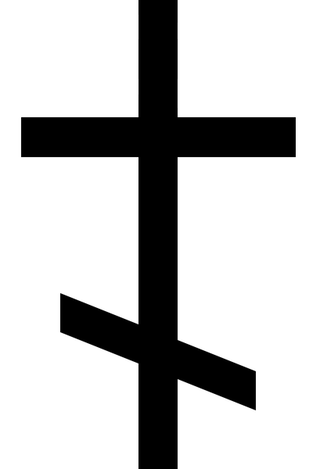
The Russian cross is a variation of the Christian cross with two crossbeams, of which the higher one is horizontal and longer, and the lower one is diagonal.
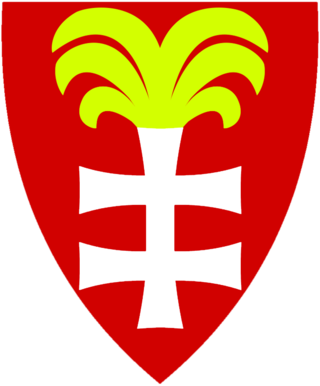
Bebek is the name of an ancient Hungarian noble family. The history of this family is connected with the areas in present-day Slovakia, notably in Gemer region, where they had their dominion.






